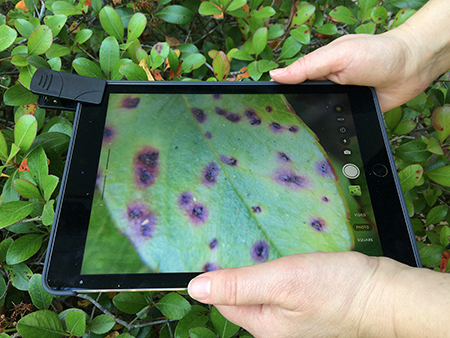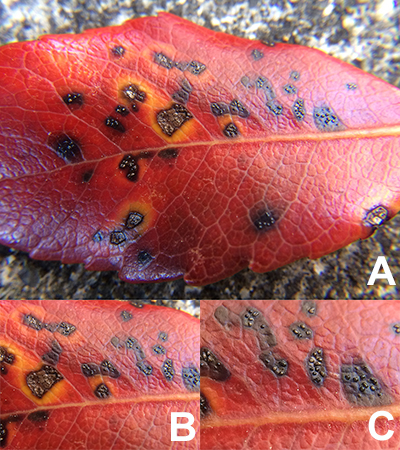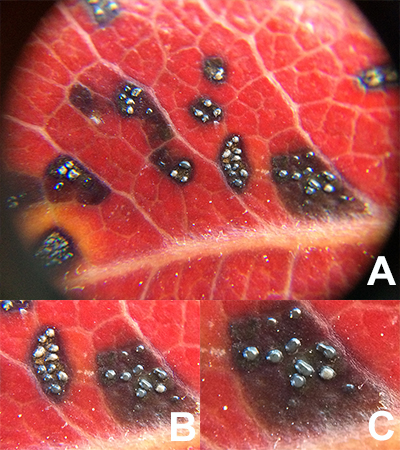A macro lens that attaches to a smart phone or tablet resolves the obstacles to student engagement that occur with the use of hand lenses (Figure 1). Macro lens attachments are easy to use, allow a larger area to be magnified, allow more than one person to make an observation at a time, and add capacity by enabling users to capture observations as a photograph to share or store for later use. Another benefit of the macro lens attachment is the magnification can be increased instantaneously with the smart device zoom. A 1-mm-wide object is ~3 mm wide on a 4-inch (10.16-cm) smart phone screen and 6 mm wide on a 9.7-inch (24.63-cm) tablet without the zoom. With full zoom, the object enlarges to 12 mm wide and 24 mm wide, respectively.
 |
Figure 1. View from a 12X macro lens attached to a tablet device in camera mode. (Courtesy E. Cantonwine) |
Macro lens attachments are inexpensive and come in a variety of magnifications; the most useful for the application discussed here are 10 to 24X. Photographs made with a $20 12X macro lens (Victony Professional, sold with a wide angle lens) are provided in Figure 2, and a $10 24X lens (Apexel Professional, APL-24XM, sold with a 12X lens) in Figure 3. Both lenses provide nice images, but the Victony lens has a wider field of view than the Apexel, which eliminates the black ring that occurs with narrower devices when zoom is not used (Figure 3). As with a hand lens, higher magnification is not always better. The depth of field of a 24X lens is shallower than a 12X lens, so the 24X lens is only useful for subjects that are nearly flat.
 |
Figure 2. Photographs of Entomosporium leaf spot of Indian hawthorn (Raphiolepis
indica), caused by Entomosporium mespili, using a 12X macro lens without zoom
(~3x) (A), with partial zoom (B), with full zoom (~12X) (C). (Courtesy E. Cantonwine) |
There are a number of different mechanisms for attachment on the market. The clip-on type, like the Victony and Apexel, is the most common, with many promoted as universal, fitting a wide variety of smart devices. At a recent outreach event, at least 100 people used the Apexel brand 12X lens with their smart phones to get a close-up view of lichens and fungi. The lens fit everyone’s phone well, although some of the bulkier cell phone cases (>15 mm thick) had to be removed first. Another universal mechanism of attachment uses magnets. Magnets provide acceptable attachment, but this system is not as useful for multiple users because it requires a magnetic ring to be adhered to each device for use.
 |
Figure 3. Photographs of Entomosporium leaf spot of Indian hawthorn (Raphiolepis
indica), caused by Entomosporium mespili, using a 24X macro lens without zoom
(~12X) (A), with partial zoom (B), with full zoom (~24X) (C). (Courtesy E. Cantonwine) |
Macro lens attachments are so simple that even non-scientists and young children can use them with ease. They were used nearly seamlessly in my lab with groups of 20-25 middle school students investigating lichens. The learning curves with these groups were brief, with two common errors; clipping the lens on backwards, and not positioning the lens close enough to the subject to obtain focus. The first issue was generally corrected without assistance, while the second issue was fixed by gently pushing devices closer to the subject. Because students could see the improvement in focus as it occurred, this correction was required only once. Many students said they would be asking their parents to buy a lens when they got home.
A macro lens attachment has many advantages compared to a hand lens in the educational setting, but there are some limitations. Their use requires a smart device, which some students may not have. Also, some students may not wish to use their device in certain situations, such as when it is raining. Although there is potential for glare from the sun to hinder observations on the screen, blocking the sun with your body is usually sufficient because of the very small area being observed. I suspect the adoption of macro lens attachments by traditional educators and extension professionals will be quick. They can even be attached to a string and worn around the neck, or smarter yet, clipped to the neck of a shirt.
